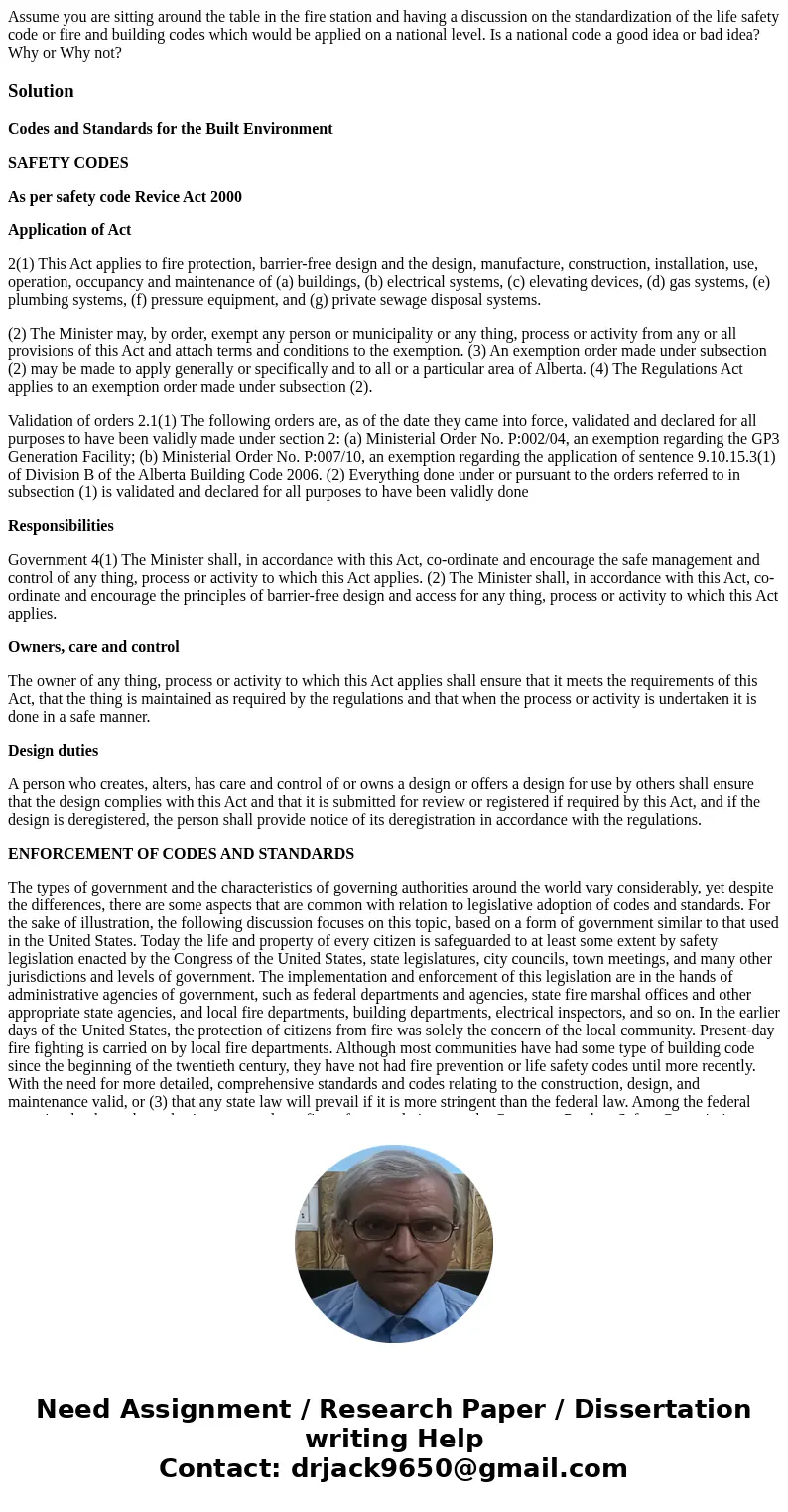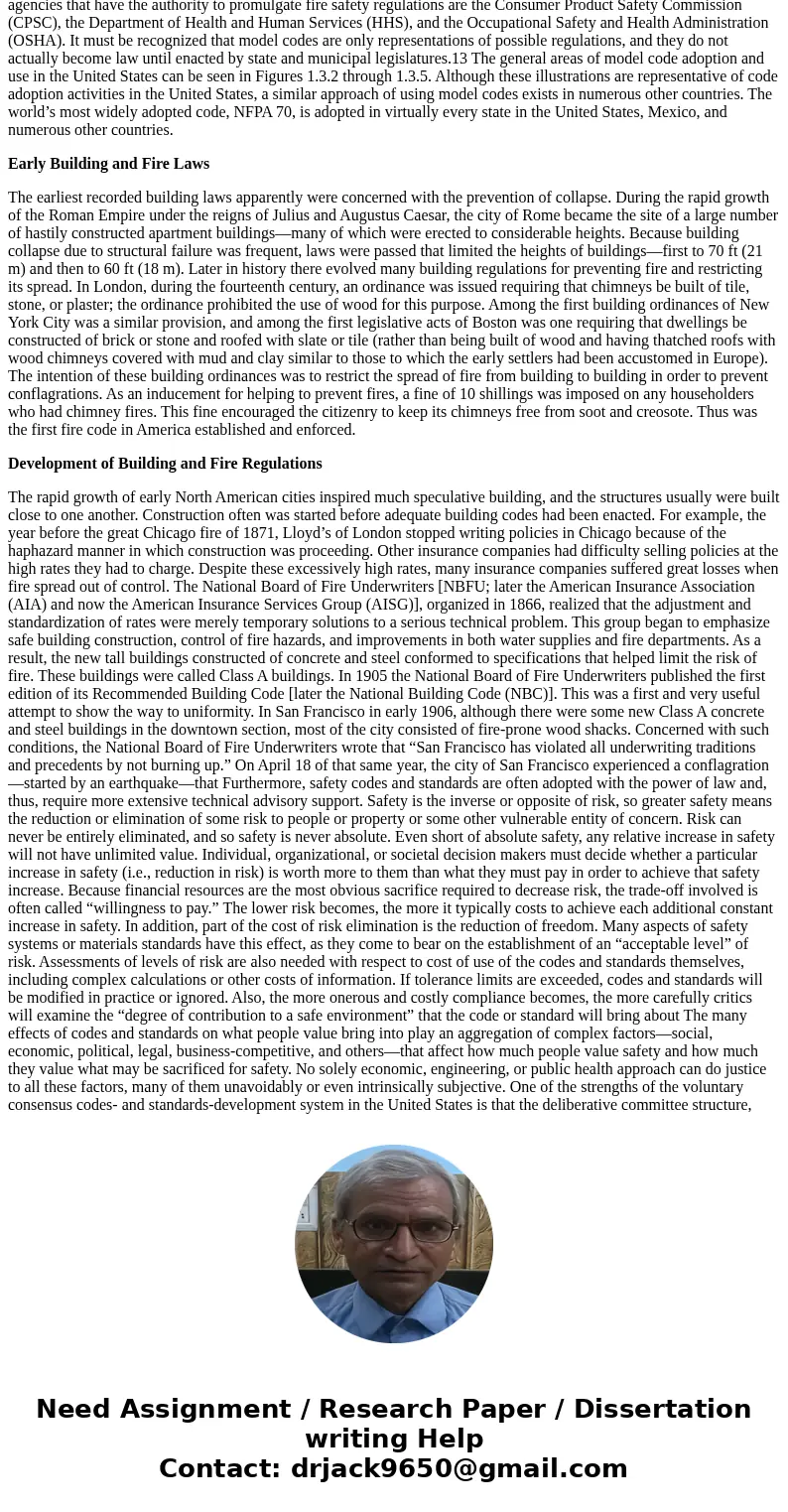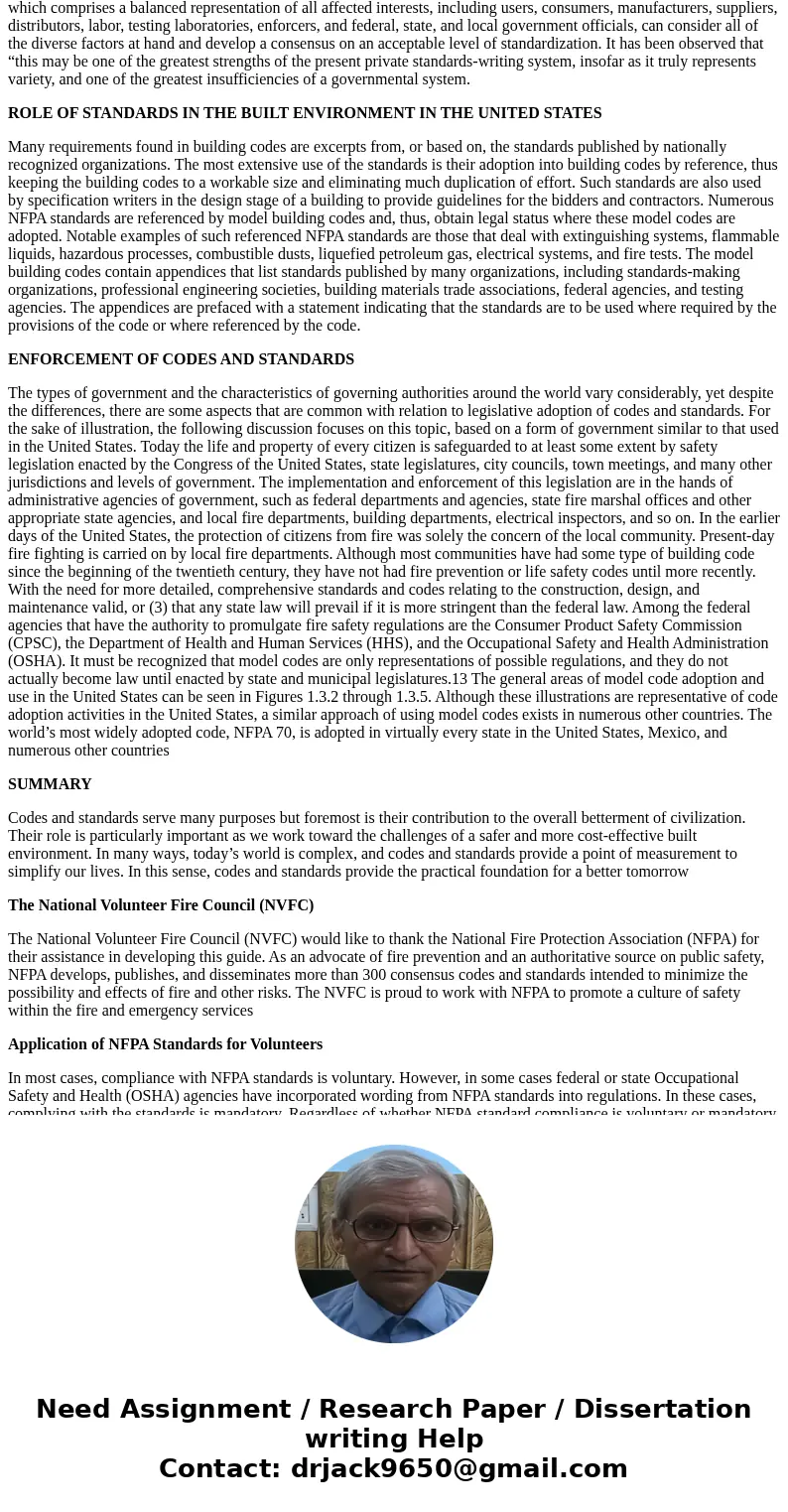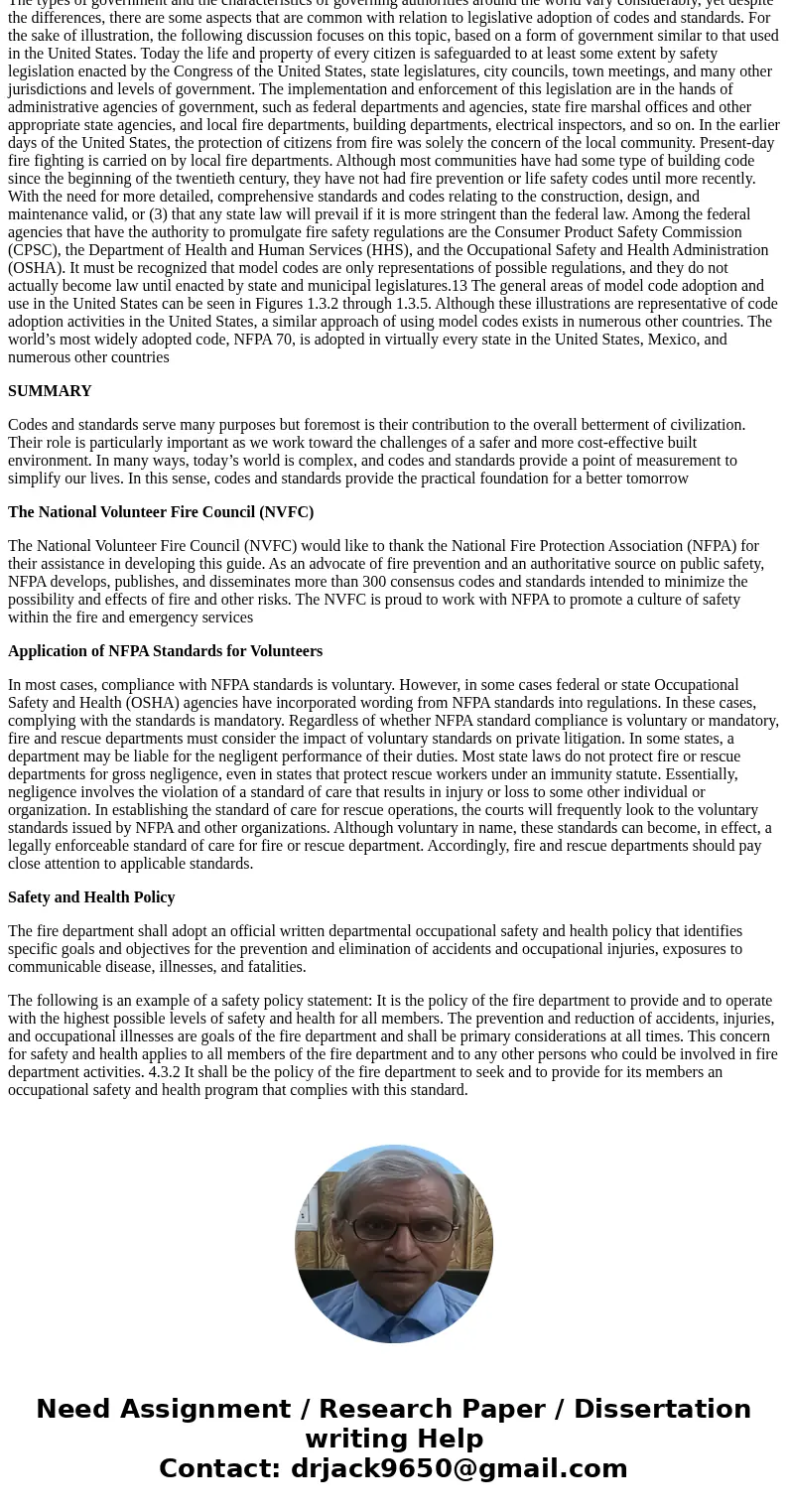Assume you are sitting around the table in the fire station
Assume you are sitting around the table in the fire station and having a discussion on the standardization of the life safety code or fire and building codes which would be applied on a national level. Is a national code a good idea or bad idea? Why or Why not?
Solution
Codes and Standards for the Built Environment
SAFETY CODES
As per safety code Revice Act 2000
Application of Act
2(1) This Act applies to fire protection, barrier-free design and the design, manufacture, construction, installation, use, operation, occupancy and maintenance of (a) buildings, (b) electrical systems, (c) elevating devices, (d) gas systems, (e) plumbing systems, (f) pressure equipment, and (g) private sewage disposal systems.
(2) The Minister may, by order, exempt any person or municipality or any thing, process or activity from any or all provisions of this Act and attach terms and conditions to the exemption. (3) An exemption order made under subsection (2) may be made to apply generally or specifically and to all or a particular area of Alberta. (4) The Regulations Act applies to an exemption order made under subsection (2).
Validation of orders 2.1(1) The following orders are, as of the date they came into force, validated and declared for all purposes to have been validly made under section 2: (a) Ministerial Order No. P:002/04, an exemption regarding the GP3 Generation Facility; (b) Ministerial Order No. P:007/10, an exemption regarding the application of sentence 9.10.15.3(1) of Division B of the Alberta Building Code 2006. (2) Everything done under or pursuant to the orders referred to in subsection (1) is validated and declared for all purposes to have been validly done
Responsibilities
Government 4(1) The Minister shall, in accordance with this Act, co-ordinate and encourage the safe management and control of any thing, process or activity to which this Act applies. (2) The Minister shall, in accordance with this Act, co-ordinate and encourage the principles of barrier-free design and access for any thing, process or activity to which this Act applies.
Owners, care and control
The owner of any thing, process or activity to which this Act applies shall ensure that it meets the requirements of this Act, that the thing is maintained as required by the regulations and that when the process or activity is undertaken it is done in a safe manner.
Design duties
A person who creates, alters, has care and control of or owns a design or offers a design for use by others shall ensure that the design complies with this Act and that it is submitted for review or registered if required by this Act, and if the design is deregistered, the person shall provide notice of its deregistration in accordance with the regulations.
ENFORCEMENT OF CODES AND STANDARDS
The types of government and the characteristics of governing authorities around the world vary considerably, yet despite the differences, there are some aspects that are common with relation to legislative adoption of codes and standards. For the sake of illustration, the following discussion focuses on this topic, based on a form of government similar to that used in the United States. Today the life and property of every citizen is safeguarded to at least some extent by safety legislation enacted by the Congress of the United States, state legislatures, city councils, town meetings, and many other jurisdictions and levels of government. The implementation and enforcement of this legislation are in the hands of administrative agencies of government, such as federal departments and agencies, state fire marshal offices and other appropriate state agencies, and local fire departments, building departments, electrical inspectors, and so on. In the earlier days of the United States, the protection of citizens from fire was solely the concern of the local community. Present-day fire fighting is carried on by local fire departments. Although most communities have had some type of building code since the beginning of the twentieth century, they have not had fire prevention or life safety codes until more recently. With the need for more detailed, comprehensive standards and codes relating to the construction, design, and maintenance valid, or (3) that any state law will prevail if it is more stringent than the federal law. Among the federal agencies that have the authority to promulgate fire safety regulations are the Consumer Product Safety Commission (CPSC), the Department of Health and Human Services (HHS), and the Occupational Safety and Health Administration (OSHA). It must be recognized that model codes are only representations of possible regulations, and they do not actually become law until enacted by state and municipal legislatures.13 The general areas of model code adoption and use in the United States can be seen in Figures 1.3.2 through 1.3.5. Although these illustrations are representative of code adoption activities in the United States, a similar approach of using model codes exists in numerous other countries. The world’s most widely adopted code, NFPA 70, is adopted in virtually every state in the United States, Mexico, and numerous other countries.
Early Building and Fire Laws
The earliest recorded building laws apparently were concerned with the prevention of collapse. During the rapid growth of the Roman Empire under the reigns of Julius and Augustus Caesar, the city of Rome became the site of a large number of hastily constructed apartment buildings—many of which were erected to considerable heights. Because building collapse due to structural failure was frequent, laws were passed that limited the heights of buildings—first to 70 ft (21 m) and then to 60 ft (18 m). Later in history there evolved many building regulations for preventing fire and restricting its spread. In London, during the fourteenth century, an ordinance was issued requiring that chimneys be built of tile, stone, or plaster; the ordinance prohibited the use of wood for this purpose. Among the first building ordinances of New York City was a similar provision, and among the first legislative acts of Boston was one requiring that dwellings be constructed of brick or stone and roofed with slate or tile (rather than being built of wood and having thatched roofs with wood chimneys covered with mud and clay similar to those to which the early settlers had been accustomed in Europe). The intention of these building ordinances was to restrict the spread of fire from building to building in order to prevent conflagrations. As an inducement for helping to prevent fires, a fine of 10 shillings was imposed on any householders who had chimney fires. This fine encouraged the citizenry to keep its chimneys free from soot and creosote. Thus was the first fire code in America established and enforced.
Development of Building and Fire Regulations
The rapid growth of early North American cities inspired much speculative building, and the structures usually were built close to one another. Construction often was started before adequate building codes had been enacted. For example, the year before the great Chicago fire of 1871, Lloyd’s of London stopped writing policies in Chicago because of the haphazard manner in which construction was proceeding. Other insurance companies had difficulty selling policies at the high rates they had to charge. Despite these excessively high rates, many insurance companies suffered great losses when fire spread out of control. The National Board of Fire Underwriters [NBFU; later the American Insurance Association (AIA) and now the American Insurance Services Group (AISG)], organized in 1866, realized that the adjustment and standardization of rates were merely temporary solutions to a serious technical problem. This group began to emphasize safe building construction, control of fire hazards, and improvements in both water supplies and fire departments. As a result, the new tall buildings constructed of concrete and steel conformed to specifications that helped limit the risk of fire. These buildings were called Class A buildings. In 1905 the National Board of Fire Underwriters published the first edition of its Recommended Building Code [later the National Building Code (NBC)]. This was a first and very useful attempt to show the way to uniformity. In San Francisco in early 1906, although there were some new Class A concrete and steel buildings in the downtown section, most of the city consisted of fire-prone wood shacks. Concerned with such conditions, the National Board of Fire Underwriters wrote that “San Francisco has violated all underwriting traditions and precedents by not burning up.” On April 18 of that same year, the city of San Francisco experienced a conflagration—started by an earthquake—that Furthermore, safety codes and standards are often adopted with the power of law and, thus, require more extensive technical advisory support. Safety is the inverse or opposite of risk, so greater safety means the reduction or elimination of some risk to people or property or some other vulnerable entity of concern. Risk can never be entirely eliminated, and so safety is never absolute. Even short of absolute safety, any relative increase in safety will not have unlimited value. Individual, organizational, or societal decision makers must decide whether a particular increase in safety (i.e., reduction in risk) is worth more to them than what they must pay in order to achieve that safety increase. Because financial resources are the most obvious sacrifice required to decrease risk, the trade-off involved is often called “willingness to pay.” The lower risk becomes, the more it typically costs to achieve each additional constant increase in safety. In addition, part of the cost of risk elimination is the reduction of freedom. Many aspects of safety systems or materials standards have this effect, as they come to bear on the establishment of an “acceptable level” of risk. Assessments of levels of risk are also needed with respect to cost of use of the codes and standards themselves, including complex calculations or other costs of information. If tolerance limits are exceeded, codes and standards will be modified in practice or ignored. Also, the more onerous and costly compliance becomes, the more carefully critics will examine the “degree of contribution to a safe environment” that the code or standard will bring about The many effects of codes and standards on what people value bring into play an aggregation of complex factors—social, economic, political, legal, business-competitive, and others—that affect how much people value safety and how much they value what may be sacrificed for safety. No solely economic, engineering, or public health approach can do justice to all these factors, many of them unavoidably or even intrinsically subjective. One of the strengths of the voluntary consensus codes- and standards-development system in the United States is that the deliberative committee structure, which comprises a balanced representation of all affected interests, including users, consumers, manufacturers, suppliers, distributors, labor, testing laboratories, enforcers, and federal, state, and local government officials, can consider all of the diverse factors at hand and develop a consensus on an acceptable level of standardization. It has been observed that “this may be one of the greatest strengths of the present private standards-writing system, insofar as it truly represents variety, and one of the greatest insufficiencies of a governmental system.
ROLE OF STANDARDS IN THE BUILT ENVIRONMENT IN THE UNITED STATES
Many requirements found in building codes are excerpts from, or based on, the standards published by nationally recognized organizations. The most extensive use of the standards is their adoption into building codes by reference, thus keeping the building codes to a workable size and eliminating much duplication of effort. Such standards are also used by specification writers in the design stage of a building to provide guidelines for the bidders and contractors. Numerous NFPA standards are referenced by model building codes and, thus, obtain legal status where these model codes are adopted. Notable examples of such referenced NFPA standards are those that deal with extinguishing systems, flammable liquids, hazardous processes, combustible dusts, liquefied petroleum gas, electrical systems, and fire tests. The model building codes contain appendices that list standards published by many organizations, including standards-making organizations, professional engineering societies, building materials trade associations, federal agencies, and testing agencies. The appendices are prefaced with a statement indicating that the standards are to be used where required by the provisions of the code or where referenced by the code.
ENFORCEMENT OF CODES AND STANDARDS
The types of government and the characteristics of governing authorities around the world vary considerably, yet despite the differences, there are some aspects that are common with relation to legislative adoption of codes and standards. For the sake of illustration, the following discussion focuses on this topic, based on a form of government similar to that used in the United States. Today the life and property of every citizen is safeguarded to at least some extent by safety legislation enacted by the Congress of the United States, state legislatures, city councils, town meetings, and many other jurisdictions and levels of government. The implementation and enforcement of this legislation are in the hands of administrative agencies of government, such as federal departments and agencies, state fire marshal offices and other appropriate state agencies, and local fire departments, building departments, electrical inspectors, and so on. In the earlier days of the United States, the protection of citizens from fire was solely the concern of the local community. Present-day fire fighting is carried on by local fire departments. Although most communities have had some type of building code since the beginning of the twentieth century, they have not had fire prevention or life safety codes until more recently. With the need for more detailed, comprehensive standards and codes relating to the construction, design, and maintenance valid, or (3) that any state law will prevail if it is more stringent than the federal law. Among the federal agencies that have the authority to promulgate fire safety regulations are the Consumer Product Safety Commission (CPSC), the Department of Health and Human Services (HHS), and the Occupational Safety and Health Administration (OSHA). It must be recognized that model codes are only representations of possible regulations, and they do not actually become law until enacted by state and municipal legislatures.13 The general areas of model code adoption and use in the United States can be seen in Figures 1.3.2 through 1.3.5. Although these illustrations are representative of code adoption activities in the United States, a similar approach of using model codes exists in numerous other countries. The world’s most widely adopted code, NFPA 70, is adopted in virtually every state in the United States, Mexico, and numerous other countries
SUMMARY
Codes and standards serve many purposes but foremost is their contribution to the overall betterment of civilization. Their role is particularly important as we work toward the challenges of a safer and more cost-effective built environment. In many ways, today’s world is complex, and codes and standards provide a point of measurement to simplify our lives. In this sense, codes and standards provide the practical foundation for a better tomorrow
The National Volunteer Fire Council (NVFC)
The National Volunteer Fire Council (NVFC) would like to thank the National Fire Protection Association (NFPA) for their assistance in developing this guide. As an advocate of fire prevention and an authoritative source on public safety, NFPA develops, publishes, and disseminates more than 300 consensus codes and standards intended to minimize the possibility and effects of fire and other risks. The NVFC is proud to work with NFPA to promote a culture of safety within the fire and emergency services
Application of NFPA Standards for Volunteers
In most cases, compliance with NFPA standards is voluntary. However, in some cases federal or state Occupational Safety and Health (OSHA) agencies have incorporated wording from NFPA standards into regulations. In these cases, complying with the standards is mandatory. Regardless of whether NFPA standard compliance is voluntary or mandatory, fire and rescue departments must consider the impact of voluntary standards on private litigation. In some states, a department may be liable for the negligent performance of their duties. Most state laws do not protect fire or rescue departments for gross negligence, even in states that protect rescue workers under an immunity statute. Essentially, negligence involves the violation of a standard of care that results in injury or loss to some other individual or organization. In establishing the standard of care for rescue operations, the courts will frequently look to the voluntary standards issued by NFPA and other organizations. Although voluntary in name, these standards can become, in effect, a legally enforceable standard of care for fire or rescue department. Accordingly, fire and rescue departments should pay close attention to applicable standards.
Safety and Health Policy
The fire department shall adopt an official written departmental occupational safety and health policy that identifies specific goals and objectives for the prevention and elimination of accidents and occupational injuries, exposures to communicable disease, illnesses, and fatalities.
The following is an example of a safety policy statement: It is the policy of the fire department to provide and to operate with the highest possible levels of safety and health for all members. The prevention and reduction of accidents, injuries, and occupational illnesses are goals of the fire department and shall be primary considerations at all times. This concern for safety and health applies to all members of the fire department and to any other persons who could be involved in fire department activities. 4.3.2 It shall be the policy of the fire department to seek and to provide for its members an occupational safety and health program that complies with this standard.




 Homework Sourse
Homework Sourse